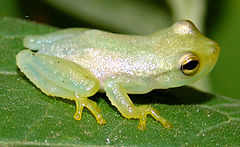Phyllodytes
| Phyllodytes[1] | |||
| Wagler, 1830[2] | |||
 Przedstawiciel rodzaju – P. luteolus | |||
| Systematyka | |||
| Domena | |||
|---|---|---|---|
| Królestwo | |||
| Typ | |||
| Podtyp | |||
| Gromada | |||
| Rząd | |||
| Rodzina | |||
| Podrodzina | |||
| Rodzaj |
Phyllodytes | ||
| Typ nomenklatoryczny | |||
| |||
| Synonimy | |||
|
| |||
| Gatunki | |||
| |||
Phyllodytes – rodzaj płazów bezogonowych z podrodziny Hylinae w obrębie rodziny rzekotkowatych (Hylidae).
Zasięg występowania
Rodzaj obejmuje gatunki występujące we wschodniej Brazylii[6].
Systematyka
Etymologia
- Phyllodytes: gr. φυλλον phullon „liść”; δυτης dutēs „nurek”, od δυω duō „nurkować”[2].
- Amphodus: gr. αμφόδους amphodous „górne i dolne zęby”, od αμφω amphō „zarówno, oba”; οδους odous, οδοντος odontos „ząb”[3]. Gatunek typowy: Amphodus wuchereri Peters, 1872.
- Lophyohyla (Lophiohyla): gr. λοφος lophos „czub, grzebień”; rodzaj Hyla Laurenti, 1768[4]. Gatunek typowy: Lophyohyla piperata Miranda-Ribeiro, 1923.
Podział systematyczny
Do rodzaju należą następujące gatunki[6]:
- Phyllodytes acuminatus Bokermann, 1966
- Phyllodytes amadoi Vörös, Dias & Solé, 2017
- Phyllodytes brevirostris Peixoto & Cruz, 1988
- Phyllodytes edelmoi Peixoto, Caramaschi & Freire, 2003
- Phyllodytes gyrinaethes Peixoto, Caramaschi & Freire, 2003
- Phyllodytes iuna Santos, Roseno, Solé & Dias, 2023
- Phyllodytes kautskyi Peixoto & Cruz, 1988
- Phyllodytes luteolus (Wied-Neuwied, 1821)
- Phyllodytes maculosus Cruz, Feio & Cardoso, 2007
- Phyllodytes magnus Dias, Novaes-e-Fagundes, Mollo, Zina, Garcia, Recoder, Vechio, Rodrigues & Solé, 2020
- Phyllodytes megatympanum Marciano, Lantyer-Silva & Solé, 2017
- Phyllodytes melanomystax Caramaschi, Silva & Britto-Pereira, 1992
- Phyllodytes praeceptor[7] Orrico, Dias & Marciano, 2018
- Phyllodytes punctatus Caramaschi & Peixoto, 2004
- Phyllodytes tuberculosus Bokermann, 1966
- Phyllodytes wuchereri (Peters, 1873)
Uwagi
- ↑ Niepoprawna późniejsza pisownia Lophyohyla Miranda-Ribeiro, 1923.
Przypisy
- ↑ Phyllodytes, [w:] Integrated Taxonomic Information System (ang.).
- ↑ a b J.J. Wagler: Natürliches System der Amphibien, mit vorangehender Classification der Säugthiere und Vogel. München, Stuttgart and Tübingen: In der J.G. Cotta’scchen Buchhandlung, 1830, s. 202. (niem.).
- ↑ a b W. Peters. Über eine, zwei neue Gattungen enthaltende, Sammlung von Batrachiern des Hrn. Dr. O. Wucherer aus Bahia, so wie über einger neue oder weniger bekannte Saurier. „Monatsberichte der Königlichen Preussische Akademie des Wissenschaften zu Berlin”. Aus dem jahre 1872, s. 768, 1872. (niem.).
- ↑ a b A. de Miranda-Ribeiro. As Phyllomesusas do Museo Paulista. „Boletim do Museu Nacional do Rio de Janeiro”. 1, s. 5, 1923. (port.).
- ↑ A. de Miranda-Ribeiro. Notas para servirem ao estudo dos Gymnobatrachios (Anura) Brasileiros. „Archivos do Museu Nacional do Rio de Janeiro”. 27, s. 64, 1926. (port.).
- ↑ a b D. Frost: Phyllodytes Wagler, 1830. [w:] Amphibian Species of the World 6.2, an Online Reference [on-line]. American Museum of Natural History. [dostęp 2024-05-31]. (ang.).
- ↑ Victor G.D. Orrico, Iuri R. Dias i Euvaldo Marciano-Jr.. Another new species of Phyllodytes (Anura: Hylidae) from the Atlantic Forest of northeastern Brazil. „Zootaxa”. 4407 (1), s. 101–110, 2018. DOI: 10.11646/zootaxa.4407.1.6. (ang.).
